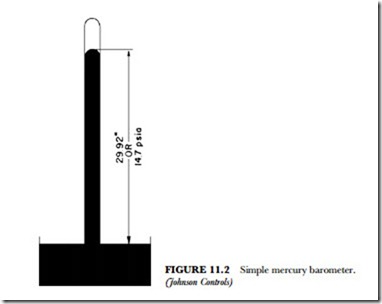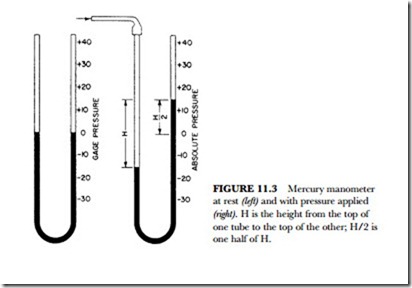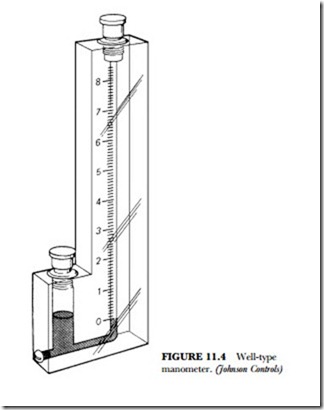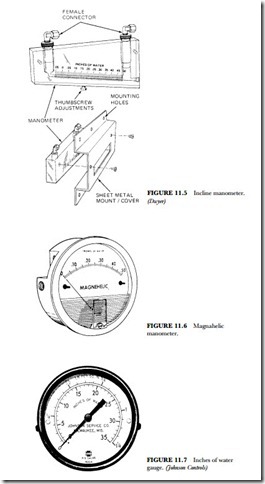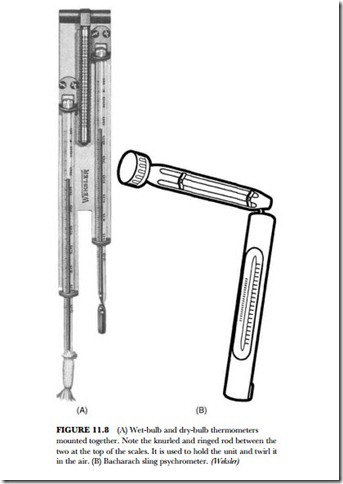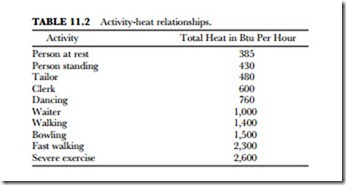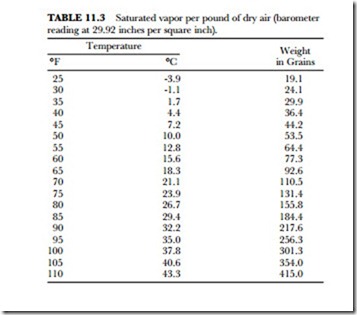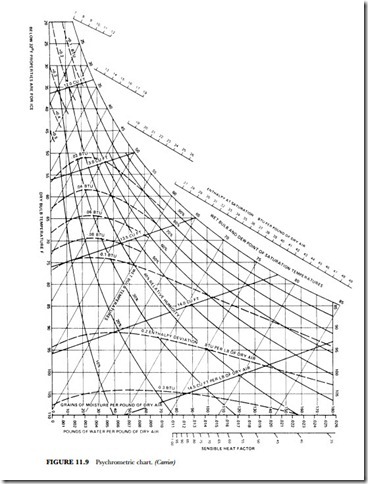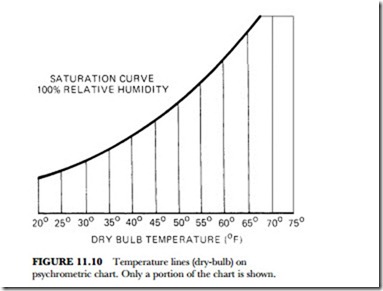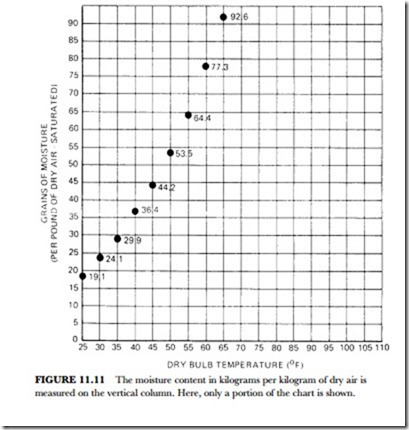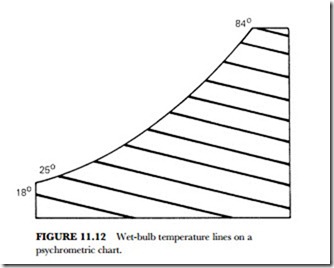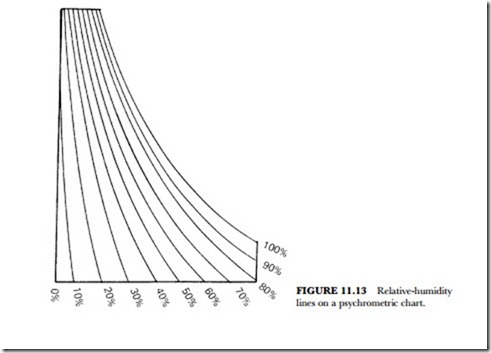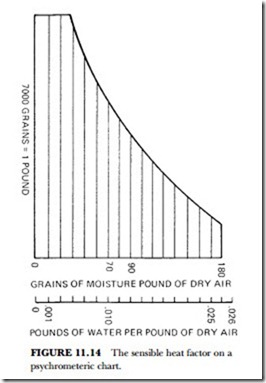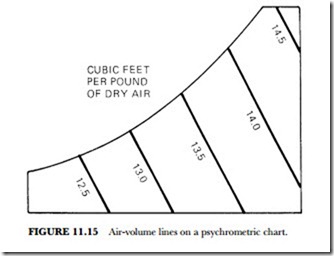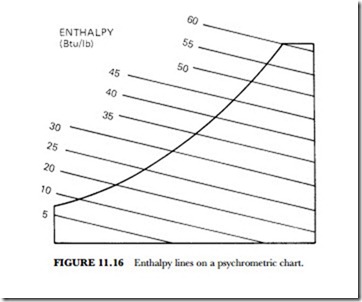PRESSURES
All devices that measure pressure must be exposed to two pressures. The measurement is always the difference between two pressures, such as gauge pressure and atmospheric pressure.
Gauge Pressure
On an ordinary pressure gauge, one side of the measuring element is exposed to the medium under pressure. The other side is exposed to the atmosphere. Atmospheric pressure varies with altitude and climatic conditions.
Thus, it is obvious that gauge pressure readings will not represent a precise, definite value unless the atmospheric pressure is known. Gauge pressures are usually designated as psig (pounds per square inch gauge). Pressure values that include atmospheric pressure are designated psia (pounds per square inch absolute).
Atmospheric Pressure
A barometer is used to measure atmospheric pressure. A simple mercury barometer may be made with a glass tube slightly more than 30 inches in length. It should be sealed at one end and filled with mercury. The open end should be inverted in a container of mercury (see Figure 11.2). The mercury will drop in the tube until the weight of the atmosphere on the surface of the mercury in the pan just supports the weight of the mercury column in the tube. At sea level and under certain average climatic conditions, the height of mercury in the tube will be 29.92 inches. The space above the mercury in the tube will be an almost perfect vacuum, except for a slight amount of mercury vapor.
A mercury manometer is an accurate instrument for measuring pressure. The mercury is placed in a glass U-tube. With both ends open to the atmosphere, the mercury will stand at the same level in both sides of the tube (see Figure 11.3). A scale is usually mounted on one of the tubes with its zero point at the mercury level.
Pressure-Measuring Devices
Low pressures, such as in an air-distribution duct, are measured with a manometer using water instead of mercury in the U-tube (see Figure 11.3). The unit of measurement, one inch of water, is often abbreviated as 1 H2O or 1 w.g. (water gauge).
Water is much lighter than mercury. Thus, a water column is a more sensitive gauge of pressure than a mercury column. Figure 11.4 shows a well-type manometer. It indicates 0 inches water gauge. Figure 11.5 shows an incline manometer. It spreads a small range over a longer scale for accurate measurement
of low pressures. Most manometers of this type use a red, oily liquid in place of water to provide a more practical and useful instrument. Figure 11.6 shows a magnahelic mechanical manometer. It is designed to eliminate the liquid in the water gauge. It is calibrated in hundredths of an inch water gauge for very sensitive measurement. Figure 11.7 shows a standard air-pressure gauge used for adjusting control instruments. It is calibrated in inches of water and psig. It is apparent from the scale that one psig is equal to 27.6 inches water gauge.
Bourdon (spring) tube gauges and metal diaphragm gauges are also used for measuring pressure. These gauges are satisfactory for most commercial uses. They are not as accurate as the manometer or barometer because of the mechanical methods involved.
Another unit of pressure measurement is the atmosphere. Zero-gauge pressure is equal to one atmosphere pounds per square inch) at sea level. For rough calculations, one atmosphere can be considered 15 psig. A gauge pressure of l5 psia is approximately two atmospheres. The volume of a perfect gas varies inversely with its pressure as long as the temperature remains constant. Thus, measuring pressures in atmospheres is convenient in some cases, as may be observed from the following example: a 30-gallon tank, open to the atmosphere, contains 30 gallons of free air at a pressure of one atmosphere. If the tank is closed and air pumped in until the pressure equals two atmospheres, the tank will contain 60 gallons of free air. The original 30 gallons now occupies only one-half of the volume it originally occupied.
Conversion charts for pressures (psi to inches of Hg) may be found in various publications. The reference section of an engineering data book is a good source.
A hygrometer is an instrument used to measure the amount of moisture in the air. If a moist wick is placed over a thermometer bulb, the evaporation of moisture from the wick will lower the thermometer reading (temperature). If the air surrounding a wet-bulb thermometer is dry, evaporation from the moist wick will
be more rapid than if the bulb thermometer is wet. When the air is saturated, no water will evaporate from the cloth wick, and the temperature of the wet-bulb thermometer will be the same as the reading on the dry- bulb thermometer. However, if the air is not saturated, the water will evaporate from the wick, causing the tempeature reading to be lower. The accuracy of the wet-bulb thermometer depends on how fast air passes over the bulb. Speeds of 5,000 feet/minute (60 miles per hour) are best, but it is dangerous to move a thermometer at that speed. Errors up to 15 percent can occur if the air movement is too slow or if there is too much radiant heat (sunlight, for example) present. A wet-bulb temperature taken with air moving at about 1 to 2 meters/second is referred to as a screen temperature, whereas a temperature taken with air moving about 3.5 meters/second or more is referred to as a sling temperature.
Properties of Air
Air is composed of nitrogen, oxygen, and small amounts of water vapor. Nitrogen makes up 77 percent, while oxygen accounts for 23 percent. Water vapor can account for 0 to 3 percent under certain conditions. Water vapor is measured in grains or, in some cases, pounds per pound of dry air. Seven thousand grains of water equal one pound.
Temperature determines the amount of water vapor that air can hold. Hotter temperatures mean that air has a greater capacity to hold water in suspension. Water is condensed out of air as it is cooled. Outside, water condensation becomes rain. Inside, it becomes condensation on the window glass. Thus, dry air acts somewhat like a sponge. It absorbs moisture. There are four properties of air that account for its behavior under varying conditions. These properties are dry-bulb temperature, wet-bulb temperature, dew-point temperature, and relative humidity.
Dry-Bulb Temperature
Dry-bulb temperature is the air temperature that is determined by an ordinary thermometer. There are certain amounts of water vapor per pound of dry air. They can be plotted on a psychrometric chart. A psychrometer is an instrument for measuring the aqueous vapor in the atmosphere. A difference between a wet- bulb thermometer and a dry-bulb thermometer is an indication of the dryness of the air. A psychrometer, then, is a hygrometer, which is a device for measuring water content in air. A psychrometric chart indicates the different values of temperature and water moisture in air.
Wet-Bulb Temperature
Wet-bulb temperature reflects the cooling effect of evaporating water. A wet-bulb thermometer is the same as a dry-bulb thermometer, except that it has a wet cloth around the bulb (see Figure 11.8A). The thermometer is swung around in the air. The temperature is read after this operation. The wet-bulb temperature is lower than the dry-bulb temperature. It is the lowest temperature that a water-wetted body will attain when exposed to an air current. The measurement is an indication of the moisture content of the air.
The Bacharach sling psychrometer, shown in Figure 11.8B, is a compact sling type that determines the percentage of relative humidity. It has a built-in slide-rule calculator that correlates wet- and dry-bulb temperatures to relative humidity. The dual-range, high and low temperature, scales are designed for better resolution. The thermometers telescope into the handle for protection when not in use. They are available in both red-spirit-filled and the mercury-filled thermometers as well as in degrees F or C. There is a built-in water reservoir that holds sufficient water for several hours of testing. It is designed for portability, ease of use, and ruggedness. Accuracy is within ±5 percent relative humidity. The thermometers are constructed of shock-resistant glass. The stems have deep-etched numbers and 1-degree scale divisions for easy reading. The mercury-filled and spirit-filled thermometers have a range of +25 F to +120 degrees F. They can be obtained in Celsius with a range of -5 to +50 degrees.
Dew-Point Temperature
Dew-point temperature is the temperature below which moisture will condense out of air. The dew point of air is reached when the air contains all the moisture it can hold. The dry-bulb and wet-bulb temperatures
are the same at this point. The air is said to be at 100 percent relative humidity when both thermometers read the same. Dew point is important when designing a humidifying system for human comfort. If the hu- midity is too high in a room, the moisture will condense and form on the windows.
Relative Humidity
Relative humidity is a measure of how much moisture is present compared to how much moisture the air could hold at that temperature. Relative humidity (rh) is based on the percentage of humidity contained in the air relative to the saturation condition of the air. A reading of 70 percent means that the air contains 70 percent of the moisture it can hold. Relative-humidity lines on the psychrometric chart are sweeping curves, as shown in Figure 11.13.
To keep the home comfortable in winter, it is sometimes necesary to add humidity. Hot-air heat will in time remove most of the moisture in the living space. The addition of moisture is accomplished in a number of ways. Humidifiers are used to spray water into the air, or large areas of water are made available to evaporate. Showers and running water also add moisture to a living space.
In summer, however, the amount of moisture per pound on the outside is greater than on the inside, especially when the room is air-conditioned. This means the vapor pressure is greater on the outside than the inside. Under these conditions, moisture will enter the air-conditioned space by any available route. It will enter through cracks, around doors and windows, and through walls. In winter, the moisture moves the other way—from the inside to the outside.
The percentage of relative humidity is never more than 100 percent. When the air is not saturated, the dry-bulb temperature will always be higher than the wet- bulb temperature. The dew-point temperature will always be the lowest reading. The greater the difference between the dew-point temperature and the dry- bulb temperature, the lower will be the percentage of relative humidity. The wet-bulb reading can never be higher than the dry-bulb reading. Nor can the dew-point reading be higher than the dry-bulb reading. Con- sider the following example:
With saturated air (100 percent humidity) temperature is dry bulb 90 degrees F, wet bulb 90 degrees F, and relative humidity 100 percent, thus dew point 90 degrees F.
With unsaturated air (less than 100 percent humidity) temperature is dry bulb 80 degrees F, wet bulb 75 degrees F, and relative humidity 80 percent, thus dew point 73 degrees F.
Manufacturers of humidifiers furnish a dial similar to a thermostat for controlling the humidity. A chart on the control tells what the humidity setting should be when the temperature outside is at a given point. Table 11.1 gives an example of what the settings should be.
The relationship between humidity, wet-bulb temperature, and dry-bulb temperature has much to do with the designing of air-conditioning systems. There are three methods of controlling the saturation of air:
1. Keep the dry-bulb temperature constant. Raise the wet-bulb temperature and the dew-point temperature to the dry-bulb temperature. Adding moisture to the air can do this. In turn, it will raise the dew-point temperature to the dry-bulb temperature, which automatically raises the wet-bulb temperature to the dry-bulb temperature.
2. Keep the wet-bulb temperature constant. Lower the dry-bulb temperature. Raise the dew- point temperature to the wet-bulb temperature. Cooling the dry-bulb temperature to the level of the wet-bulb temperature does this. The idea here is do it without adding or removing any moisture. The dew point is automatically raised to the wet-bulb temperature.
3. Keep the dew-point temperature constant and the wet-bulb temperature at the dew-point temperature. Cooling the dry-bulb and wet-bulb temperatures to the dew-point temperature can do this.
People and Moisture
People working inside a building or occupied space give off moisture as they work. They also give off heat. Such moisture and heat must be considered in determining air-conditioning requirements. Table 11.2 indicates some of the heat given off by the human body when working.
Psychrometric Chart
The psychrometric chart holds much information (see Figure 11.9). However, it is hard to read. It must be studied for some time. The dry-bulb temperature is located in one place and the wet-bulb in another. If the two are known, it is easy to find the relative humidity and other factors relating to checking air. Both customary and metric psychrometric charts are available.
Air contains different amounts of moisture at different temperatures. Table 11.3 shows the amounts of moisture that air can hold at various temperatures.
An explanation of the various quantities shown on a psychrometric chart will enable you to understand the chart. The different quantities on the chart are shown separately on the following charts. These charts will help you see how the psychrometric chart is constructed (see Figure 11.10).
Across the bottom, the vertical lines are labeled from 25 to 110 degrees F in increments of 5 degrees. These temperatures indicate the dry-bulb temperature (see Figure 11.11). The horizontal lines are labeled
from 0 to 180 degrees F. This span of numbers represents the grains of moisture per pound of dry air (when saturated). The outside curving line on the left side of the graph indicates the wet-bulb, dew-point, or saturation temperature (see Figure 11.12).
At 100 percent saturation the wet-bulb temperatures are the same as the dry-bulb and the dew-point tem- peratures. This means the wet-bulb lines start from the 100 percent saturation curve. Diagonal lines represent the wet-bulb temperatures. The point where the diagonal line of the wet bulb crosses the dry bulb’s vertical line is the dew point. The temperature of the dew point will be found by running the horizontal line to the left and reading the temperature on the curve, since the wet-bulb and dew-point temperatures are on the curve.
The curving lines within the graph indicate the percentage of relative humidity. These lines are labeled 10, 20, and so on in percent (see Figure 11.13). The pounds of water per pound of dry air are shown in the
bottom column of numbers. The grains of moisture per pound of dry air are shown in the middle column of the three columns of numbers (see Figure 11.14).
Table 11.3 shows that one pound of dry air will hold 19.1 grains of water at 25 degrees F (-3.9 degrees C). One pound of dry air will hold 415 grains of water at 110 degrees F. It can be seen that the higher the temperature, the more moisture the air can hold. This is one point that should be remembered. To find the weight per grain, divide 1 by 7000 to get 0.00014 pounds per grain. Therefore, on the chart 0.01 pounds corresponds to about 70 grains. The volume of dry air (cubic feet per pound) is represented by diagonal lines (see Figure 11.15). The values are marked along the lines. They represent the cubic feet of the mixture of
vapor and air per pound of dry air. The chart indicates that volume is affected by temperature relationships of the wet- and dry-bulb readings. The lines are usually at intervals of 1/2 cubic foot per pound.
Enthalpy is the total amount of heat contained in the air above 0 degrees F (-17.8 degrees C) (see Figure 11.16). The lines on the chart that represent enthalpy are extensions of the wet-bulb lines. They are ex- tended and labeled in Btu per pound. This value can be used to help determine the load on an air-conditioning unit.
